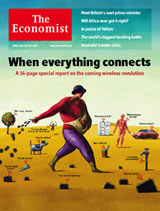Last Friday there were two surprising (to me, anyway) front page stories about ubicomp. First, the Economist has a special report on "The coming wireless revolution." The end of the first paragraph reads "In coming years wireless will vanish entirely from view, as communications chips are embedded in a host of everyday objects. Such chips, and the networks that link them together, could yet prove to be the most potent wireless of them all."
The next paragraph begins "Just as microprocessors have been built into everything in the past few decades, so wireless communications will become part of objects big and small."
This combination of ideas--wireless, network, microprocessor, everyday objects--is of course the core recipe for ubiquitous computing. Tod and I at ThingM have been working with RFIDs and embedded networking for a while and we think that it's certainly The Future (in terms of augmenting everyday objects). It's going to require deep changes in terms of the design of how people interact with devices and how companies create them.
One company that seems to get it is, again surprisingly, Nintendo. Or at least they got it with the Wiimote, which was featured on the front page of Friday's Wall Street Journal in a story called Magic Wand: How Hackers Make Use Of Their Wii-motes. In it, the WSJ discusses how the open standards of the Wiimote--as Tod pointed out to me, it's a Bluetooth device that uses off-the-shelf components and communication standards--allow people to hack it , including hack it to use Tod's Roomba control software (which is mentioned implicitly in discussing Chris Hughes' hack)> I think that the availability of these communication standards also allowed the company to focus on creating great interaction, rather than on inventing technology. This is the key shift: once there's enough momentum behind a set of standards, technology development shifts from hardware to software, from engineering to interaction design. At the core of these articles is a recognition that wireless technologies have matured enough that we can focus not on how they work, but what they can do for us.
(yes, I'm also amused that the WSJ called the story "Magic Wand")




